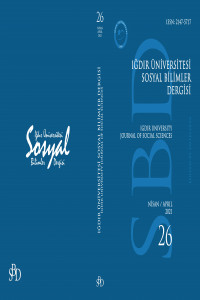Öz
Osmanlı arşivinde yerel ipekçiliğe dair en eski belgeler Rumeli’ye aittir. Bizans döneminden intikal eden ve belgelerde “mor ipek” denilen ilkel ipekböcekçiliğine dair bilgiler belirlenmiştir. Osmanlı devleti zamanında, Selanik’in içinde bulunduğu Rumeli coğrafyasında yerel ipekçiliğe dair büyük bir teknik dönüşüm gerçekleştirilmiş ve kültive edilmiş ipekböcekçiliği hayata geçirilmiştir. 19. Yüzyıla doğru Selanik’in içinde bulunduğu Rumeli ve Mora ipek üretimi, Osmanlı Devleti toplam üretiminin ağırlıklı kısmını teşkil etmiştir. Selanik’in içinde bulunduğu Rumeli coğrafyası, İran’a mesafe olarak uzak olmasına rağmen bu denli hızlı ve nitelikli ipek üretiminin sağlanması Bizans’tan intikal eden ilkel ipekçilik alt yapısıyla ve geleneksel Orta Asya Türk ipekçiliğinin, bölgede yeniden ihya edilmesi ile açıklanabilir. Selanik ipekçiliğe dair Osmanlı arşivindeki ilk belge 1547 tarihlidir ve bu belge Osmanlı ipekçiliğine dair tespit edilen en erken tarihli belgedir. Selanik bölgesi ipekçiliğinin 18. Yüzyılın sonlarına doğru arttığı, 19. Yüzyılda ise hızla yükseldiği görülmüştür. Limanı ve üzerinde birleşen yollar ağı ile Selanik bölgesi ipekçiliği kendine özgü bir konum arz etmektedir.
Anahtar Kelimeler
Kaynakça
- BOA, İE.ML.., 33/3171
- BOA,A.{DVNSMHM.d.., 62/473 BOA,C,ML,722/29551
- BOA,C,ML,540/22211,2
- BOA,C,ML,540/22225,3 BOA,I.DH.627/436361
- BOA,TFR.I..SL…168/16702
- BOA,16702AE.SAMD.III.25/2367
- BOA, İE.ML…122/11569
- BOA.SMST.II..125/13716
- BOA.C..AS…1009/44188 BOA,C..BH…105/5059 BOA,C..ML…10/443
- BOA,D..BŞM.TRE.d….15696/1 BOA,HAT,52875976 BOA,C..ML…228/9537 BOA, HR.MKT.,306/64 BOA,I.MVL.238/8466
- Aristotle’s, History Of Anımals. M.A., st. John’s College Oxford. Çeviren: Rıchard Cresswell, London.(1883):124-125.
- Çizakça, Murat. “A Short History of the Bursa Silk Industry (1500-1900)”, Journal of the Economic and Social History of the Orient,23(1980):142-152.
- Dalsar, Fahri. Türk Ticaret ve Sanayi Tarihinde Bursa’da İpekçilik. İstanbul:1960.
- Gisela, Marie Augusta Richter. “Silk in Greece”, American Journal of Archaeology,33 (1929): 27-33, https://www.jstor.org/stable/497644.
- Haussig, Hans Wilhelm .İpek Yolu ve Orta Asya Kültür Tarihi. (Müjdat Kayayerli çev.), Kayseri:1997.
- İnalcık, Halil. “İpek”. DİA. Diyanet Vakfı Yayınları,22 (2000):362-365.
- Jacoby, Davis.”The Byzantine Social Elite and the Market Economy, Eleventh to Mid-Fifteenth Centur”, Brill’s Studies in Intellectual History, (2015), 67-86.
- Journal of the Royal Society of Arts. 62/3234 (NOVEMBER 13, 1914):1035- 1036, The royal society for arts, manufactures and commerce.
- Xinru Liu. The Silk Road in World History. London: Oxford University press, 2010.
- Oikonomidès, Nicolas. “Silk Trade and Production in Byzantium from the Sixth to the Ninth Century: The Seals of Kommerkiariois” Dumbarton Oaks Papers, Published by: Dumbarton Oaks, Trustees for Harvard University, 40: 33-53, Stable URL: https://www.jstor.org/stable/1291528 Accessed: 16-11-2019 12:22 UTC
Öz
The oldest documents on local sericulture in the Ottoman archives pertain to Rumelia. Information regarding the primitive practice of silkworm breeding which was inherited from the Byzantine period and was referred to as "purple silk" in the documents has been identified. During the Ottoman period, a great technical transformation was realized in the region of Rumelia, where Salonika is located, and cultivated sericulture was put into practice. Towards the 19th century, the silk production in the Peloponnese and Rumelia, where Salonika is located, formed the predominant part of the total production of the Ottoman Empire. The fact that such quick and high-quality silk production was achieved although the region of Rumelia, where Salonika is located, is far away from Iran in distance can be explained by the primitive sericulture infrastructure inherited from Byzantium and by the revival of traditional Central Asian Turkic sericulture in the region. The first document in the Ottoman archives concerning Salonikan sericulture is dated 1547, and this document is the earliest-dated document which has been identified regarding Ottoman sericulture. It has been observed that the sericulture in the Salonika region increased towards the end of the 18th century and rose quickly in the 19th century. With its harbor and the network of roads connecting with each other in it, the sericulture of the Salonika region presents a distinctive quality.
Anahtar Kelimeler
Kaynakça
- BOA, İE.ML.., 33/3171
- BOA,A.{DVNSMHM.d.., 62/473 BOA,C,ML,722/29551
- BOA,C,ML,540/22211,2
- BOA,C,ML,540/22225,3 BOA,I.DH.627/436361
- BOA,TFR.I..SL…168/16702
- BOA,16702AE.SAMD.III.25/2367
- BOA, İE.ML…122/11569
- BOA.SMST.II..125/13716
- BOA.C..AS…1009/44188 BOA,C..BH…105/5059 BOA,C..ML…10/443
- BOA,D..BŞM.TRE.d….15696/1 BOA,HAT,52875976 BOA,C..ML…228/9537 BOA, HR.MKT.,306/64 BOA,I.MVL.238/8466
- Aristotle’s, History Of Anımals. M.A., st. John’s College Oxford. Çeviren: Rıchard Cresswell, London.(1883):124-125.
- Çizakça, Murat. “A Short History of the Bursa Silk Industry (1500-1900)”, Journal of the Economic and Social History of the Orient,23(1980):142-152.
- Dalsar, Fahri. Türk Ticaret ve Sanayi Tarihinde Bursa’da İpekçilik. İstanbul:1960.
- Gisela, Marie Augusta Richter. “Silk in Greece”, American Journal of Archaeology,33 (1929): 27-33, https://www.jstor.org/stable/497644.
- Haussig, Hans Wilhelm .İpek Yolu ve Orta Asya Kültür Tarihi. (Müjdat Kayayerli çev.), Kayseri:1997.
- İnalcık, Halil. “İpek”. DİA. Diyanet Vakfı Yayınları,22 (2000):362-365.
- Jacoby, Davis.”The Byzantine Social Elite and the Market Economy, Eleventh to Mid-Fifteenth Centur”, Brill’s Studies in Intellectual History, (2015), 67-86.
- Journal of the Royal Society of Arts. 62/3234 (NOVEMBER 13, 1914):1035- 1036, The royal society for arts, manufactures and commerce.
- Xinru Liu. The Silk Road in World History. London: Oxford University press, 2010.
- Oikonomidès, Nicolas. “Silk Trade and Production in Byzantium from the Sixth to the Ninth Century: The Seals of Kommerkiariois” Dumbarton Oaks Papers, Published by: Dumbarton Oaks, Trustees for Harvard University, 40: 33-53, Stable URL: https://www.jstor.org/stable/1291528 Accessed: 16-11-2019 12:22 UTC
Ayrıntılar
| Birincil Dil | İngilizce |
|---|---|
| Bölüm | Araştırma Makalesi |
| Yazarlar | |
| Yayımlanma Tarihi | 30 Nisan 2021 |
| Yayımlandığı Sayı | Yıl 2021 Sayı: 26 |


